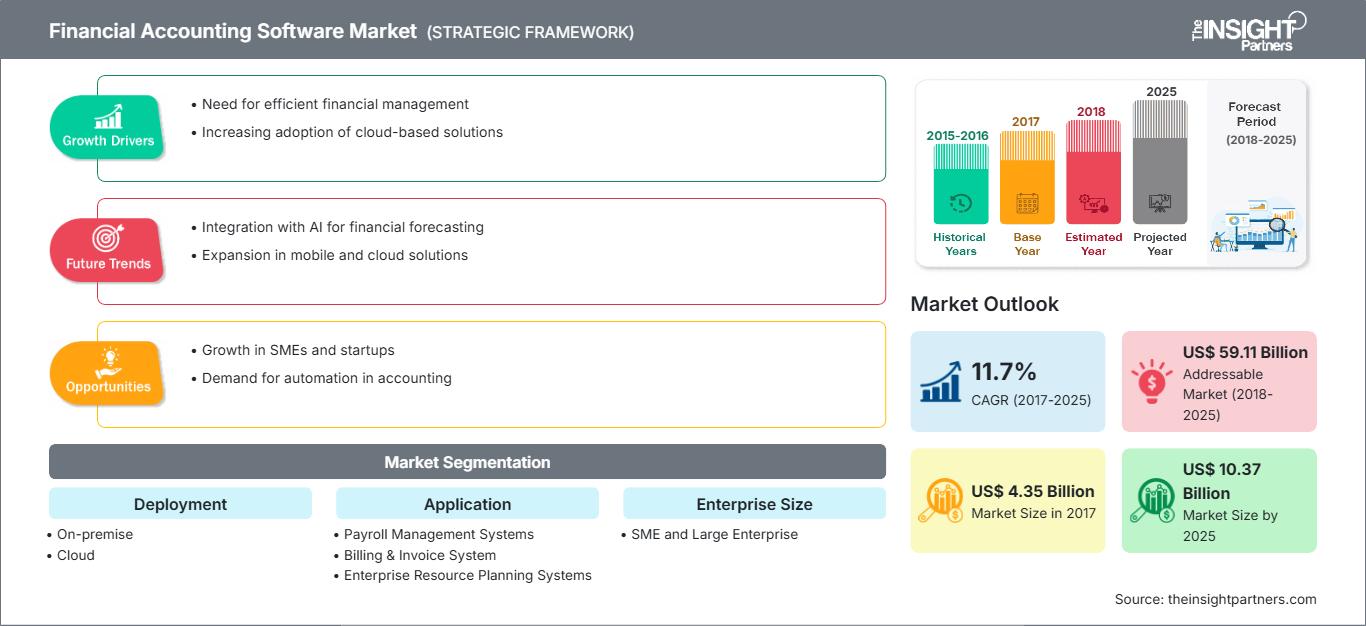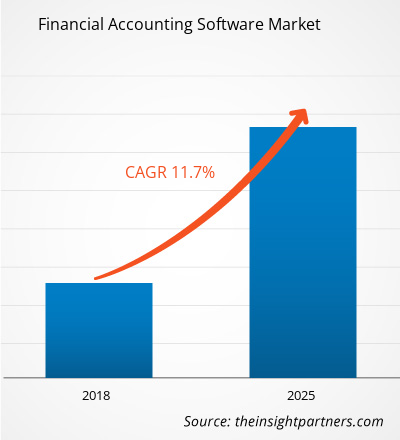El mercado mundial de software de contabilidad financiera alcanzó los 4.350 millones de dólares estadounidenses en 2017 y se espera que crezca a una tasa de crecimiento anual compuesta (TCAC) del 11,7% durante el período de previsión 2018-2025, hasta alcanzar los 10.370 millones de dólares estadounidenses en 2025.
América del Norte fue el mercado geográfico líder y se prevé que siga siendo el principal contribuyente a los ingresos durante todo el período de pronóstico. Los rápidos avances tecnológicos, las numerosas inversiones y las políticas gubernamentales favorables en Occidente han impulsado el dominio de América del Norte en el mercado de software de contabilidad financiera.
Perspectivas del mercado
El software de contabilidad basado en la nube está ganando protagonismo.
El modelo basado en la nube permite a las organizaciones optar por un modelo de pago por uso que puede reducir considerablemente los costos iniciales. Las tarifas del proveedor son proporcionales al uso de las aplicaciones y aumentan con este. Aun así, siempre serán menores en comparación con el modelo de infraestructura instalada localmente. Además, este modelo elimina por completo las preocupaciones sobre el mantenimiento, el servicio y las reparaciones o el tiempo de inactividad por fallas. Según el tipo de aplicación implementada, la tarifa puede ser significativa si se requieren múltiples integraciones y la transferencia de datos desde sistemas heredados antiguos para una transición más fluida.
Obtendrá personalización gratuita de cualquier informe, incluyendo partes de este informe, análisis a nivel de país y paquetes de datos de Excel. Además, podrá aprovechar excelentes ofertas y descuentos para empresas emergentes y universidades.
Mercado de software de contabilidad financiera: Perspectivas estratégicas

- Obtenga las principales tendencias clave del mercado que se describen en este informe.Esta muestra GRATUITA incluirá análisis de datos, que abarcarán desde tendencias de mercado hasta estimaciones y pronósticos.
Existe una creciente demanda de una solución eficiente y rentable para la gestión de tareas relacionadas con la contabilidad.
El software de contabilidad financiera permite automatizar las operaciones sistemáticas para registrar los datos contables, medir sus indicadores y generar informes sobre las actividades financieras de la empresa. Este software es una herramienta fundamental para los contables, ya que reduce significativamente el papeleo y aporta rentabilidad al usuario. En cualquier entorno empresarial donde se haya implementado un software de contabilidad financiera, se presentan cuellos de botella críticos en las operaciones contables, como información de auditoría inexacta o el incumplimiento de las normas y requisitos legales e internos. Por lo tanto, el software de contabilidad se considera un activo que reduce costos e impulsa la productividad.
Dado que los sistemas de contabilidad tradicionales resultaban tediosos para los empleados, quienes debían mantenerlos y notificar puntualmente a la gerencia sobre la elaboración de los informes fiscales, la necesidad de una solución más eficaz se había vuelto mucho más urgente. El uso de software de contabilidad financiera elimina la necesidad de intervención humana y, por lo tanto, garantiza informes fiscales oportunos y conformes a la ley.
Segmentación por información de aplicaciones
A nivel mundial, el rápido crecimiento empresarial genera la necesidad de diversas soluciones de software para facilitar las operaciones comerciales. Un sistema de contabilidad eficiente es fundamental para que cualquier empresa agilice y simplifique sus procesos contables. Según su aplicación, el mercado global de software de contabilidad financiera se divide en sistemas de gestión de nóminas, sistemas de facturación, sistemas de planificación de recursos empresariales (ERP) y sistemas de gestión de tiempo y gastos, entre otros. Las principales características de un sistema de facturación incluyen la creación de registros de clientes, plantillas de comunicación predefinidas, configuración de divisas e informes de facturas, pagos e impuestos. La implementación de este sistema permite reducir los pagos atrasados, minimizar los pagos omitidos y mantener una imagen profesional.
Segmentación por tamaño de empresa
Actualmente, el software de contabilidad financiera es fundamental para cualquier sistema empresarial, ya que abarca la gestión de nóminas, tesorería, impuestos, contabilidad entre empresas y divisas, entre otras funciones. Este software proporciona a las organizaciones mayor optimización, velocidad, fiabilidad y sostenibilidad. Según el tamaño de la empresa, el mercado global de software de contabilidad financiera se divide en pequeñas y medianas empresas (pymes) y grandes empresas. En 2017, las pymes lideraron el mercado global de software de contabilidad financiera, y se prevé que mantengan su liderazgo hasta 2025.
Se observó que las nuevas iniciativas de mercado eran la estrategia más adoptada en el mercado global de software de contabilidad financiera. A continuación, se enumeran algunas de las iniciativas de mercado recientes:
2018: Microsoft y Blackbaud anunciaron una inversión conjunta en la Iniciativa de Nube Integrada para Organizaciones sin Fines de Lucro, que ayudará a acelerar la innovación en la nube en las áreas que abordan las necesidades críticas del mercado a lo largo del ciclo de vida de la misión.
2018: National Oilwell Varco, proveedor líder de equipos, tecnología y servicios para la industria mundial del petróleo y el gas, y Microsoft Corp. anunciaron un acuerdo para colaborar en la mejora digital de la plataforma de ventas y las operaciones de servicio de campo de NOV para ofrecer experiencias de primer nivel aprovechando Microsoft Dynamics 365 para optimizar los procesos comerciales, acceder a datos e información en tiempo real y revolucionar las operaciones de servicio de campo con un enfoque digital y centrado en la movilidad.
2018: Walmart y Microsoft anunciaron una alianza estratégica para impulsar la transformación digital de Walmart en el sector minorista. Walmart eligió a Microsoft como su proveedor estratégico de servicios en la nube, aprovechando la gama completa de soluciones en la nube de Microsoft.
Perspectivas regionales del mercado de software de contabilidad financiera
Los analistas de The Insight Partners han explicado en detalle las tendencias y los factores regionales que influyen en el mercado de software de contabilidad financiera durante el período de previsión. Esta sección también analiza los segmentos y la geografía del mercado de software de contabilidad financiera en Norteamérica, Europa, Asia Pacífico, Oriente Medio y África, y Sudamérica y Centroamérica.
Alcance del informe de mercado de software de contabilidad financiera
| Atributo del informe | Detalles |
|---|---|
| Tamaño del mercado en 2017 | 4.350 millones de dólares estadounidenses |
| Tamaño del mercado para 2025 | 10.370 millones de dólares estadounidenses |
| Tasa de crecimiento anual compuesto global (2017 - 2025) | 11,7% |
| Datos históricos | 2015-2016 |
| período de previsión | 2018-2025 |
| Segmentos cubiertos | Por despliegue
|
| Regiones y países cubiertos | América del norte
|
| Líderes del mercado y perfiles de empresas clave |
|
Densidad de los actores del mercado de software de contabilidad financiera: comprensión de su impacto en la dinámica empresarial
El mercado de software de contabilidad financiera está creciendo rápidamente, impulsado por la creciente demanda de los usuarios finales debido a factores como la evolución de las preferencias de los consumidores, los avances tecnológicos y una mayor conciencia de los beneficios del producto. A medida que aumenta la demanda, las empresas amplían su oferta, innovan para satisfacer las necesidades de los consumidores y aprovechan las nuevas tendencias, lo que impulsa aún más el crecimiento del mercado.

- Obtenga una visión general de los principales actores del mercado de software de contabilidad financiera.
Mercado global de software de contabilidad financiera: segmentación
Mercado global de software de contabilidad financiera: por implementación
- En las instalaciones
- Nube
Mercado global de software de contabilidad financiera: por aplicación
- Sistemas de gestión de nóminas
- Sistema de facturación y cobro
- Sistemas de planificación de recursos empresariales
- Sistemas de gestión de tiempo y gastos
- Otros
Mercado global de software de contabilidad financiera – Por tamaño de empresa
- PYME
- Gran empresa
Mercado global de software de contabilidad financiera – Por geografía
- América del norte
- A NOSOTROS
- Canadá
- México
- Europa
- Francia
- Alemania
- Italia
- Rusia
- Reino Unido
- El resto de Europa
- Asia Pacífico (APAC)
- Corea del Sur
- Porcelana
- India
- Australia
- Japón
- Resto de Asia Pacífico
- Oriente Medio y África (MEA)
- Arabia Saudita
- Emiratos Árabes Unidos
- Sudáfrica
- Resto de Oriente Medio y África
- Sudamerica
- Brasil
- Argentina
- Resto de Sudamérica (SAM)
Mercado de software de contabilidad financiera: perfiles de empresas
- Corporación Microsoft
- Oracle Corporation
- FreshBooks, Inc.
- Información
- INTUIT, INC.
- LucaNet AG
- Xero Limited
- El Grupo Sage plc
- Wave Financial Inc.
- Corporación Zoho
- Análisis histórico (2 años), año base, pronóstico (7 años) con CAGR
- Análisis PEST y FODA
- Tamaño del mercado, valor/volumen: global, regional y nacional
- Industria y panorama competitivo
- Conjunto de datos de Excel
Informes recientes
Informes relacionados
Testimonios
Razón para comprar
- Toma de decisiones informada
- Comprensión de la dinámica del mercado
- Análisis competitivo
- Información sobre clientes
- Pronósticos del mercado
- Mitigación de riesgos
- Planificación estratégica
- Justificación de la inversión
- Identificación de mercados emergentes
- Mejora de las estrategias de marketing
- Impulso de la eficiencia operativa
- Alineación con las tendencias regulatorias






















 Obtenga una muestra gratuita para - Mercado de software de contabilidad financiera
Obtenga una muestra gratuita para - Mercado de software de contabilidad financiera